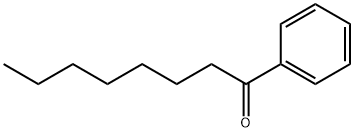A6523712
1-Octanethiol , 98% , 111-88-6
Synonym(s):
n-Octyl mercaptan;1-Octanethiol;Mercaptan C8;n-Octyl mercaptan;Octyl mercaptan
CAS NO.:111-88-6
Empirical Formula: C8H18S
Molecular Weight: 146.29
MDL number: MFCD00004912
EINECS: 203-918-1
Update time: 2022-07-08
PRODUCT Properties
| Melting point: | -49 °C |
| Boiling point: | 197-200 °C (lit.) |
| Density | 0.843 g/mL at 25 °C (lit.) |
| vapor pressure | 0.3 hPa (20 °C) |
| refractive index | n |
| Flash point: | 55 °F |
| storage temp. | Store below +30°C. |
| solubility | 0.004g/l |
| pka | 10.55±0.10(Predicted) |
| form | Liquid |
| color | Clear colorless |
| Specific Gravity | 0.843 (20/4℃) |
| Odor | at 0.10?%?in?dipropylene glycol. sulfurous |
| Odor Threshold | 0.0016ppm |
| Water Solubility | Not miscible in water. |
| BRN | 1733101 |
| Exposure limits | NIOSH: Ceiling 0.5 ppm(3.0 mg/m3) |
| Stability: | Stable. Incompatible with strong acids, strong oxidizing agents, alkali metals. |
| LogP | 4.21 at 20℃ |
| CAS DataBase Reference | 111-88-6(CAS DataBase Reference) |
| NIST Chemistry Reference | 1-Octanethiol(111-88-6) |
| EPA Substance Registry System | 1-Octanethiol (111-88-6) |
Description and Uses
OT can be used as a sulfur precursor for the preparation of shell for CdSe/CdS quantum dots. It forms ligands that help in enhancing the power efficiency of hetero-junction nanorod sensitized solar cells as it enhances the electron extraction from the nanorod and TiO2 interface. OT based stabilized coating on copper nanoparticles (CuNPs) may be used in the dispersion of these colloidal particles in different sample solutions. It can be used to improve charge injection by creating a monolayer on gold source-drain electrode surfaces for bottom-contact thin-film transistors (TFTs).
Safety
| Symbol(GHS) |   GHS07,GHS09 |
| Signal word | Warning |
| Hazard statements | H317-H410 |
| Precautionary statements | P273-P280-P302+P352 |
| Hazard Codes | F,N,Xn,Xi |
| Risk Statements | 11-67-65-50/53-43-36/37-20-36/37/38 |
| Safety Statements | 7-16-57-45-36/37/39-29-26 |
| OEL | Ceiling: 0.5 ppm (3.0 mg/m3) [15-minute] |
| RIDADR | UN 1170 3/PG 2 |
| WGK Germany | 3 |
| Autoignition Temperature | 240 °C |
| TSCA | Yes |
| HazardClass | 9 |
| PackingGroup | III |
| HS Code | 29309070 |
| Hazardous Substances Data | 111-88-6(Hazardous Substances Data) |
| Toxicity | LD50 orally in Rabbit: 2000 - 2450 mg/kg |





